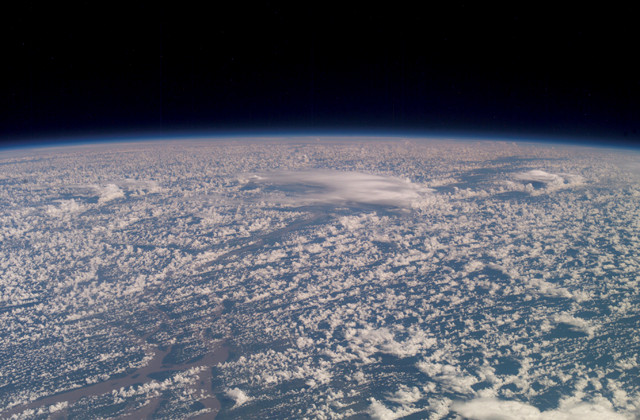
by Kate S. Zalzal Tuesday, November 15, 2016

Low tropical clouds seen from the International Space Station. Clouds like these reflect solar radiation back into space; without them, Earth's surface warms. Credit: NASA.
Fly over the tropical or subtropical oceans and you’ll see a white blanket of clouds covering the blue-green water. These low clouds, typically forming less than 2 to 3 kilometers above the ocean surface and covering up to 40 percent of Earth’s surface, play a critical role in the planet’s energy balance. Now, new research using satellite data and climate models to investigate how these clouds respond to climate change shows that they play a large role in regulating climate sensitivity.
Low-lying clouds reflect solar radiation back into the upper atmosphere and space. “If they are not there, more sunlight is absorbed by the dark ocean underneath and the Earth heats up,” says Tapio Schneider, an atmospheric scientist at Caltech and co-author of the new study published in the Journal of Climate. Deep clouds — those that extend higher in the atmosphere — also reflect sunlight, but they exert a strong greenhouse effect too, holding in radiation and warmth.
“As the planet warms, the amount that it warms will depend on what happens to low clouds,” says Stephen Klein, an atmospheric scientist at Lawrence Livermore National Laboratory in California who was not involved in the study. But these tropical low clouds are not well represented in climate models.
“Models now have a resolution of about 100 kilometers to 50 kilometers. But the dynamics that control these low clouds have scales of tens of meters; we just can’t resolve that in a climate model,” Schneider says. Consequently, differences in cloud behavior account for most of the spread in climate projections across models.
Because of this, climate sensitivity estimates — a temperature metric used to characterize how the global climate system will respond to changes in greenhouse gas concentrations — have remained broad. “Climate sensitivity estimates have been basically unchanged for 40 years,” Schneider says. “If you want to hit greenhouse gas concentration and warming targets, like those in the [2016] Paris [climate] agreement, how much you can emit before you reach those targets crucially depends on the climate sensitivity.”
Schneider and Florent Brient, a postdoctoral fellow at ETH Zürich and lead author on the paper, looked at 15 years of satellite data to measure how Earth’s shortwave and longwave radiation fluxes changed in response to changing surface conditions. The researchers analyzed simulations with 29 different climate models over this period and looked to see which models best reproduced the known observations. “We wanted to know if we could use these 15 years of data to say which climate models are good and which models are bad,” Schneider says. “And from there: What’s the climate sensitivity of the models that do reproduce observations well?”
They found that as the underlying surface warmed, tropical low-cloud formation decreased. “This is an amplifying feedback on the warming,” Schneider says. “As it gets warmer, you reduce the cloud cover and that means less radiation reflects back into space and we get more warmth.”
The simulations also showed that the climate models that best reproduced the observations were primarily ones with higher climate sensitivities. “We have clear evidence that these cloud feedbacks are positive and that low climate sensitivities [estimated by some models] can probably be excluded as unrealistic,” Schneider says. “We think that climate sensitivity is likely quite high, so if you want to satisfy the Paris [agreement] threshold you have to emit less than was previously considered most likely.”
“We’re making progress on the cloud feedback problem,” Klein says, noting that this paper is one of several studies published in recent months that identify positive cloud feedbacks, “but now we need to explain this physically.” Efforts to refine the uncertainty range are also important, he says. “[Low tropical clouds] are a major piece of climate sensitivity, but they’re not the only piece.”
© 2008-2021. All rights reserved. Any copying, redistribution or retransmission of any of the contents of this service without the expressed written permission of the American Geosciences Institute is expressly prohibited. Click here for all copyright requests.